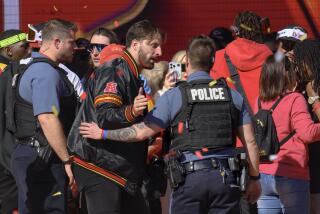National Guard enters Ferguson streets as protests turn tense
- Share via
Reporting from Ferguson, Mo. — Although the Missouri National Guard was deployed and a curfew was lifted Monday, what began as a peaceful demonstration turned restive after dark, as this racially polarized St. Louis suburb hunkered down for another night of painful protests stemming from the police killing of Michael Brown.
About 10 p.m., someone threw plastic water bottles, and the crowd protesting the Aug. 9 shooting surged, confronting nervous police in riot gear. Suddenly, the National Guard mobilized, after keeping a low profile throughout the day.
Sirens screamed. Authorities ordered protesters to disperse. Tear gas wafted over the darkened streets. But the standoff continued, and police made several arrests.
It was a day of demonstration and investigation, as a pathologist for the Brown family said his preliminary autopsy suggested no sign of a struggle by the unarmed black man. President Obama said U.S. Atty. Gen. Eric H. Holder Jr. would visit Ferguson on Wednesday, and Holder announced that FBI agents had conducted several new interviews in the neighborhood where Brown was killed.
Police have said Brown, 18, was shot after confronting Ferguson Police Officer Darren Wilson inside his police car. But at least one witness who was with Brown that afternoon has said Brown was shot as he walked away from the officer with his hands raised, then was struck by additional bullets.
Dr. Michael Baden, a renowned New York forensic pathologist who performed a preliminary autopsy for the dead man’s family, said Brown had been shot at least six times and probably could have survived all but one. Baden said he believed the bullet that hit the top of Brown’s head and traveled through his brain was probably fatal.
Appearing before reporters in the sanctuary of the Greater St. Mark Family Church in St. Louis on Monday, Baden and three of the Brown family attorneys displayed the diagram of Brown’s wounds that was released with the autopsy.
Two of the gunshot wounds were graze wounds, Baden said, and two may have been reentry wounds. Baden also said there were abrasions on the right side of Brown’s face, which he believes occurred when Brown was struck in the head with a bullet and fell to the ground.
Baden’s report suggested that Brown was shot from a distance of at least one to two feet. But he said he needed access to Brown’s clothing before he could make a more definitive determination.
Attorney Benjamin Crump said the Brown family had asked for the independent autopsy because of uncertainty at the time over whether federal officials would conduct their own examination of Brown’s body.
“It answers just the basic questions,” Crump said, “the number of shots, which was always a question that not only the family had, but the citizens of Ferguson and people all over the country.”
At the White House, Obama repeated a call for calm in the community and said the amount of military-style equipment that police forces have been receiving from the federal government needed to be reviewed.
Obama said the Justice Department would carefully monitor events in Ferguson and the use of Missouri National Guard units.
National Guard mobilization should be “limited and appropriate,” Obama said, noting that the decision to use the military units had been made by state officials.
It’s important to ensure that “peaceful protesters” have an opportunity to air their grievances, Obama said, adding that law enforcement officers need to be able to protect communities against people who are using the unrest as an excuse for looting or violence.
And he decried a “gulf of mistrust” between residents and police that exists in “too many communities.”
Holder did not identify the new FBI leads and said more than 40 FBI agents were canvassing the neighborhood where Brown had been shot. He said a third autopsy on Brown’s body was being performed Monday “by one of the most experienced medical examiners in the United States military.”
Local officials also have performed an autopsy, but its findings have not been released.
The attorney general requested the public’s patience during the Justice Department’s investigation, but voiced concern about the separate state investigation.
“The selective release of sensitive information that we have seen in this case so far is troubling to me,” he said.
Although Ferguson was not under curfew Monday night, police told demonstrators — some waving roses at dusk — that they needed to keep moving and avoid congregating on sidewalks and parking lots.
A midnight-to-5 a.m. curfew that had been in effect for two nights was lifted for Monday evening. But each night, demonstrators clashed with police and troopers, who used tear gas to disperse the crowd. At least two people were shot overnight Sunday, seven people were arrested, and officials managing the police response complained they were pelted with bottles and Molotov cocktails as gunshots rang out.
Missouri Gov. Jay Nixon issued the executive order early Monday to bring in the National Guard, saying in a statement that its “limited mission” will be to protect the command post so local law enforcement officials can ensure the safety of peaceful demonstrators.
Community and civic leaders who have been in Ferguson for the recent demonstrations told reporters Monday that they were worried about another challenging night.
Malik Shabazz, a former New Black Panthers leader who has been working in Ferguson trying to keep demonstrations peaceful, said he thought the National Guard would exacerbate the situation.
“We have a tough job tonight,” he said, adding that he didn’t want peaceful demonstrations “overshadowed by agents and provocateurs.”
On West Florissant Avenue, Toriano Johnson, a barber at Prime Time Barbershop, said the curfew had backfired.
“You’re trying to shut people up. That’s not going to work,” he said. “You can move them around, but it’s still going to be a movement until justice is served.”
Shortly before the bottles began flying Monday night, Capt. Ronald Johnson, the Missouri State Highway Patrol officer in charge of security in Ferguson, strode through the dark up West Florissant Avenue, the scene of so much violence and tension since Brown’s death.
A police helicopter thundered overhead as groups of people, some carrying signs, some waving red roses, marched down the sidewalk. Police vehicles prowled the avenue, red and blue lights flashing.
Asked why police would not permit protesters to stand still, Johnson said the constant movement was to prevent infiltrators from blending in with the peaceful crowds and wreaking havoc, as had occurred Sunday night, when tear gas was hurled at marchers who said they had done nothing wrong.
But Johnson said he saw Molotov cocktails being thrown — not by marchers at the front of the pack, but by others behind them.
“Protesters do not need to stand still,” he said when a woman challenged the official orders. “They need to be heard.”
Hennessy-Fiske and Susman reported from Ferguson and Raab from Los Angeles. Times staff writers Matt Pearce in Ferguson and Richard A. Serrano and David Lauter in Washington and Maria L. La Ganga in Seattle contributed to this report.
More to Read
Sign up for Essential California
The most important California stories and recommendations in your inbox every morning.
You may occasionally receive promotional content from the Los Angeles Times.













